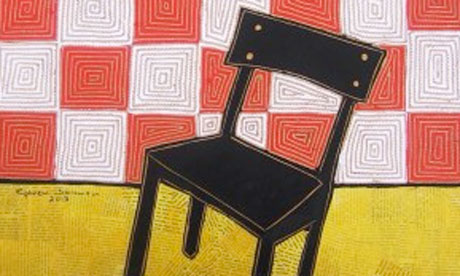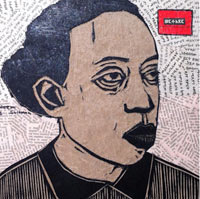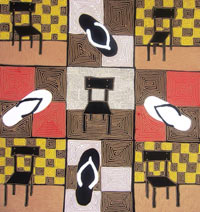Chairs, slippers and contemporary Ethiopia: the work of Ephrem Solomon
Artist reflects on the way modern and traditional lifestyles both clash and combine in the present

Ephrem Solomon's work differs from the prevailing artistic style inEthiopia in many ways. Although his art is also two-dimensional and on canvas, a strong graphic emphasis makes it stand out from the ever-dominant paintings, be they figurative or abstract.
 Solomon was born in Addis Ababa in 1983, and developed an interest in art early. After high school he studied fine art and graphic design, which shows in his portfolio. His works is often very descriptive and literal, focusing on the world around him; the city of Addis, its people, places, spaces and nature. Objects such as the signature chair and slippers are incorporated as a reflection on broader political and social themes."My works portrays the distance between what the governed people need and want and what the response is from the governors. I have tried to picture, as precisely as possible, the actual and innocent feeling of the governed," Solomon says.
Solomon was born in Addis Ababa in 1983, and developed an interest in art early. After high school he studied fine art and graphic design, which shows in his portfolio. His works is often very descriptive and literal, focusing on the world around him; the city of Addis, its people, places, spaces and nature. Objects such as the signature chair and slippers are incorporated as a reflection on broader political and social themes."My works portrays the distance between what the governed people need and want and what the response is from the governors. I have tried to picture, as precisely as possible, the actual and innocent feeling of the governed," Solomon says.
With a limited colour-scale and somewhat minimalistic style, Solomon combines the tradition of woodcut and collage with graphic design, and creates compelling contemporary artworks that balance different styles, traditions and eras. "In a world where newness has become a value in and of itself, I am more moved by the compliment that what I am doing technically feels like something from the past, while embodying something that is currently relevant," he says.Solomon reflects on the different dimensions of society and time that he experiences in contemporary Ethiopia, where modern and traditional lifestyles both clash and go hand-in-hand – creating a tension that serves as an ideal playground for an artist.
Bits and pieces of old newspaper get a new life in Solomon's hands, meticulously combined to form a patchwork on which his signature chairs and slippers stand out. Asked about the symbolism of the objects, he said the slippers represented the "ways and manners" shared with society while the chairs "symbolise the walk of an individual stepping onto the slipper's journey".Against this backdrop, elements often perform solo – installing a sense of loneliness and absence. Nobody is sitting on the chairs, nor wearing the slippers, and people are always alone. This feeling is only emphasised by the limited colour-scope. According to Solomon this reflects a "…simplicity drawn from my personal life and experience within myself and the surrounding society, simply describing in an easy going way life".
However, he often adds strong contrasting full bright colours to place the focus on particular objects or planes.
 Exist Chair. Image: Ephrem Solomon
Exist Chair. Image: Ephrem Solomon
At once minimalistic and naïve and drawing on tradition in a contemporary scope, Solomon navigates in a vacuum of time and space, introducing viewers to elements of Ethiopian life while at once reflecting critically on them. His graphic style and signature elements provide the observer with an at once aesthetic and thought-provoking experience.
No comments:
Post a Comment